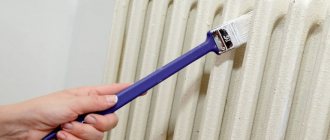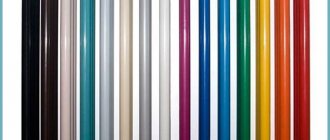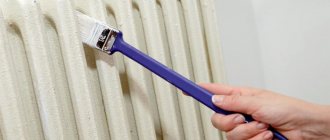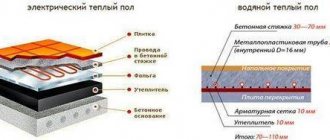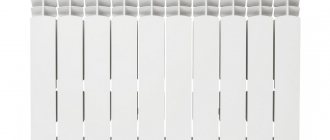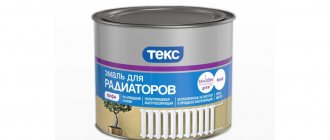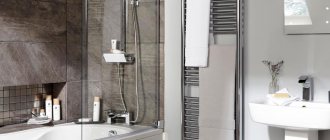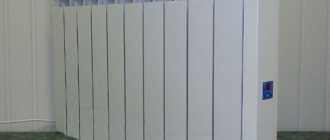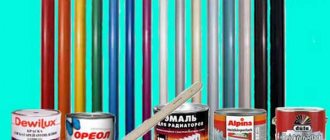When renovating residential or industrial premises, almost every person wants to choose high-quality consumables that are safe for health and have good performance. A particularly important issue in this matter is the choice of paint for radiators. The difficulty is that if it is chosen incorrectly, it will take quite a long time for the treated surfaces to dry completely. Then, when the radiators are heated, the room will constantly be filled with a pungent and unpleasant odor, and the layer will easily peel off.
Due to the fact that heating radiators often change their temperature and often heat up to too high levels, the colorant used must be calculated taking these features into account. Therefore, you should give preference only to well-tested brands that produce high-quality products that are heat-resistant, do not emit unpleasant odors, do not turn yellow when heated frequently, and also meet all generally accepted requirements for these products.
Types of paints for batteries
Today, many manufacturing companies offer a fairly wide range of products such as odorless paint for radiators. Thanks to this, buyers have the opportunity to choose the most suitable type for themselves:
- Acrylic enamel;
- Alkyd enamel;
- Oil enamel;
- Water based.
All types differ from each other in production technology, composition and characteristics.
Acrylic enamel
Acrylic paints:
- have no characteristic odor and are excellent for interior work.
- Their widespread use in everyday life is also due to the fact that they dry quickly .
- are characterized by increased moisture resistance ,
- uniform application on any surface,
- and are also absolutely safe for people.
- Due to the fact that the substance contains special additives, the paint layer does not begin to crack and turn yellow when the temperature of the radiator or battery increases.
- In addition, it should be noted that manufacturers offer a huge range of colors , so acrylic paint for heating radiators is often used when decorating surfaces.
How to bleed air from a heating radiator: remove air pockets correctly.
Learn more about how to clean soot from a boiler at home: step-by-step instructions here.
Which radiators to choose for heating a private house: we take into account every little detail.
As for the disadvantages, the most significant of them is the high cost . However, it fully corresponds to the good performance qualities of the paint.
Alkyd enamel
Alkyd paints, manufactured using the latest technologies, have the following advantages:
- A surface covered with a layer of such a substance is resistant to elevated temperatures - it does not crack when heated to 1200C ;
- High strength ;
- Homogeneous layer structure during application;
- Good resistance to abrasion when operating radiators and radiators;
- A wide range of colors allows you to choose almost any color;
- The layer maintains its integrity for a long time.
However, in addition to the advantages, there is also a disadvantage - for several days after painting, an unpleasant odor , which may subsequently appear if the heating is strong enough. In addition, some brands sometimes fade a little and may also change shade.
Water based enamel
Odorless, water-dispersion paint for hot radiators is an excellent option for coating radiators. It differs from other types in a number of features:
- It is made from ordinary water, so it is absolutely safe for people and the environment;
- Special dispersed particles are not harmful ;
- No unpleasant odor;
- It takes very little time to dry completely ;
- Apply easily and evenly;
- Thanks to the water-repellent effect, painted batteries can be washed without destroying the layer;
- Suitable for use in a wide variety of spaces .
The disadvantage is that the color range is not very diverse , because it is mostly only white.
Oil enamel
Oil products are in quite high demand due to a number of their advantages:
- No sharp and unpleasant odor after application and further heating of batteries and radiators;
- They are divided into colored and colorless ;
- Easy to apply to metal surfaces;
- Form a uniform layer ;
- Excellent for use inside both residential and non-residential premises;
- Low cost compared to other types of battery paints;
- Can be used for artistic decoration of surfaces - applying patterns and complex designs.
The downside is that it takes a very long time . This is due to the fact that a solvent is added to the paint.
Alkyd enamel for radiators “Oreol”
In the life of any of us, sooner or later there comes a time when something needs to be painted or, even worse, it’s time to renovate the apartment. The latter happened to me too. Regarding the heating radiators, it was decided not to change them, but only to paint them. This, in fact, is what we will talk about...
Since the radiators in the room are a little younger than me, they were painted with everyone’s favorite PF-115. Radiator before repainting. A wash has been applied here and there. The radiator before repainting. I needed a paint that would be guaranteed to fit on top of the PF shell (acrylic paint is out of the question here, literally and figuratively; it doesn’t fit on top of alkyd paint), but at the same time would not fade in a couple of months, like pentaphthalic paint. I decided to try the domestic alkyd-based enamel for radiators “Oreol” from “EMPILS”. And, as it turned out, in vain.
One fine day, nothing foreshadowed trouble, I prepared the surface (degreased, dried, treated with R800 sandpaper), covered it with GF-021 primer. The radiator was coated with primer before painting and a day later, after drying and treating the surface with the same R800, I began to apply “Oreol”... Manufacturer's promises
When opening the can, a sharp smell of something rotten hit my nose, although the enamel is quite “fresh” and, since it is alkyd-based, there is nothing particularly rotten there. I didn’t immediately like the consistency of the enamel - it was quite thick, although it was stored in a closed container. I had to dilute it a little with white spirit. I applied the paint with a brush, it applied quite well, but there were big problems with coverage - the primer showed through in places. But that's not so bad. If desired, you can apply a second layer (although this will cause additional expenses, since approximately 700 grams out of the available 900 were used in one layer for an 8-section radiator).
After repainting the battery began to look like this. Everything is beautiful, the enamel is snow-white and even shines. But the joy did not last long. This, so to speak, touch-dry product took as much as 18 hours to dry, although this time was stated as complete drying time. It dried completely only after another night (the total drying time is day, night, day, and another night).
Before the start of the heating season, everything was fine, but joy quickly gave way to disappointment. As soon as the batteries warmed up, literally a week later the enamel began to turn yellow. And now the radiator looks like it was painted with regular PF-115, and not with some special enamel for radiators (yes, we still haven’t gotten around to the wall :))). Current condition of the radiator. If you look closely, you can see that the low-heat areas have faded less.
To summarize, I would like to say that this enamel did not live up to the high trust placed in it and the hopes placed on it. Although it is glossy and snow-white, it absolutely does not retain its properties when heated. For a cost of 390 rubles per 900 g. This is, to put it mildly, not acceptable.
I don't recommend buying it. IMHO, the future belongs to acrylic enamels.
Thank you for reading to the end. I hope it was useful to you.
How to choose the right paint for radiators?
A wide range of different brands leads to the fact that buyers are faced with the problem of which paint to choose. Therefore, when choosing, you must pay attention to whether the enamel meets the following requirements:
- lie flat on metal products;
- Provide protection against rust and corrosion damage;
- Withstand elevated temperatures ;
- Maintain the original color for a long time.
When choosing paint, it is important to consider the material from which the radiator is made.
In addition, it is also necessary to take into account what material the batteries and radiators are made of. After all, they can be made from a variety of metals, as well as their alloys. Experts recommend following several tips:
- For devices made of steel, aluminum and bimetallic composition, it is better to use acrylic or alkyd paints;
- except oil-based for cast iron batteries . However, in order for the substance to lay down in an even and thin layer, it must be mixed with a thinner;
- It is better to refuse to use oil paints, even of the most famous brands, because they very rarely perform protective and decorative functions at the same level as others
Surface preparation
When preparing to paint, it is important to thoroughly prepare the surface to be painted. It is better to do the work in the summer, when the radiator is cold. If you have to paint during the heating season, you should turn off the hot water supply and wait a few hours for the radiators to cool down.
Attention! The maximum permissible temperature of the painted surface cannot exceed +30 degrees Celsius. At higher temperatures, the paint will dry too quickly and will not adhere firmly.
Painting a radiator is not a difficult task, but it requires the use of special paints and varnishes. Paint without a strong odor will provide an aesthetic appearance and comfort during further operation of the heating system.
It is necessary to properly prepare the surface to be painted and ensure drying conditions. Sometimes even a special paint for painting batteries with increased heat resistance and excellent adhesion to the surface can become damaged during operation - cracks and irregularities will appear.
Why do adverse events occur despite the use of specialized products? The main reason is improper surface preparation.
Old cast iron and steel batteries must be carefully prepared before being repainted:
- The surface must be clean, dry and smooth.
- First, you should remove the old coating (if it is peeling off), thoroughly wipe the ribs with abrasive paper, wipe, and dry.
- The surface of the battery must be dry, free of dust, with degreased water and detergent.
- Old rusty coatings, rust should be removed using a wire brush or sandpaper.
- Copper elements should be rubbed with steel wool to remove dirt and patina.
- The metal parts of the radiator must be primed, preferably with an anti-corrosion primer.
How to paint correctly?
There are two ways to apply the product: over an existing coating or from scratch. In both cases, the entire process is performed in two steps:
- Preparatory work;
- Application of the substance.
Preparation
In the first case, it is necessary to knock off the crust of their old enamel over the entire surface and in hard-to-reach places, performing the so-called sanding. After removing the old paint from the radiators, they should be treated with a rust converter. If there is no coating on the surface, then it must first be pre-cleaned of residual grease, dirt and dust so that they do not distort the color of the freshly applied layer, and then coated with an anti-corrosion compound.
To obtain the highest quality result, the preparatory work should be done in the following order:
- The old layer is deleted ;
- Places with rust are carefully cleaned until a metallic sheen appears;
- The entire surface is sanded using sandpaper;
- The product must be degreased with white spirit or a slightly alkaline solution ;
- A primer is applied to protect the metal from corrosion.
Painting
Before you begin directly painting the batteries, you need to ensure the appropriate conditions.
- So, the device must be turned off ,
- and the temperature of its surface should be the same as in the room, but not lower than 150C . Otherwise, the base will not dry and will not be able to polymerize.
- In order for the result to have a neat appearance, the radiator or battery must be removed .
- To reliably protect the surface from corrosion, the internal surfaces, back panel, and lower parts of the slats .
It is important to paint the radiator when the heating is turned off, otherwise the base will not dry.
- Painting begins from the inner ribs , rubbing the substance well with a brush. In this case, you need to make sure that no drips appear.
- After everything has dried, they again and the front panels are also captured . It is better to apply the paint in several layers so that there are no gaps.
- After this, the device should not be connected for 5-12 hours so that the enamel has time to completely polymerize. If the work is done correctly, the result will last for about five years .
Procedure for painting heating radiators
Just a few phrases about the most convenient order in which to paint heating radiators. To make the work easier, paint the inner surface first. If you are right-handed, it is better to move from right to left, if you are left-handed - vice versa. This way there is less chance of getting dirty. Then the outer surface is painted in the same direction.
Don't forget to cover everything around with newspapers or paper (and the floor too)
Apply the composition from above and rub it in up and down movements. Rub the paint thoroughly, without trying to immediately achieve a perfectly painted surface. After the first layer, slightly less colored areas are acceptable. It's much better than drips. They will close when applying the second layer, and drips will have to be cleaned off with sandpaper after they have completely dried.
Popular brands of odorless battery paints
Almost all companies that produce such products offer paints that are suitable for painting radiators and batteries, performing protective and decorative functions.
Among alkyd enamels, the following brands are especially popular:
- "Miranol";
- "Malta 30";
- "Jamaica 90";
- "Dufa Heizkorperlack";
- "Tex."
From the assortment of acrylic enamel the following are often purchased:
- "Radiator Paint";
- "VGT";
- "VGT Profi";
- "Jobi Termoaquaemail";
- "Barbados";
- "Colorika Aqua";
- "Ceresit CF 33"
- "Tikkurila";
- "Euro Extra 20";
- "Caparol Samtex 7 ELF".
Water-based paints are also in great demand:
- "Tikkurila Thermal";
- "Dulux Master Lux Aqua".
Of the oil types, the following brands are often preferred:
- "Alpina Heizkorper".
These brands differ from each other in color, some properties and price. Each buyer can choose the product that will fully meet his requirements.
